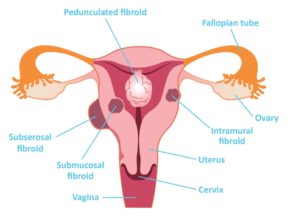Uterine fibroids [UF] are benign tumours of smooth muscle cells and fibrous connective tissue that develop within the walls of the uterus. They are the most common gynaecological problem experienced by women, being of clinical significance in 20–40% of women of childbearing age.
UF may occur singly but most often are multiple and vary in size from few millimetres to more than 20 cm in diameter, significantly enlarging the abdominal cavity. They are named according to their location. Intramural fibroids lie wholly within the uterine walls, submucosal fibroids project into the uterine cavity and subserosal fibroids project from the outer surface of the uterus. They may also be pedunculated, where they are attached to the uterine wall by a “stalk”.
UF are responsible for significant morbidity in the female population. The most common clinical symptoms are prolonged bleeding (30%), pelvic pain with or without dysmenorrhoea or pressure symptoms (34%), infertility (27%), and recurrent pregnancy loss (3%). Other symptoms associated with UF include anaemia (consequent on heavy menstrual bleeding), urinary incontinence, and sexual dysfunction. The cause of fibroids is unknown. Although there is little data on long term untreated prognosis of UF, it appears that symptoms from fibroids do not resolve spontaneously, although fibroids shrink after the menopause.

- Very heavy and prolonged menstrual periods
- Pain in the back of the legs
- Pelvic pain or pressure
- Pain during sexual intercourse
- Pressure on the bladder which leads to a constant need to urinate, incontinence, or the inability to empty the bladder
- Pressure on the bowel which can lead to constipation and/or bloating
- An enlarged abdomen which may be mistaken for weight gain or pregnancy
Subserosal fibroids typically develop on the outer uterine wall. This type of fibroid tumor can continue to grow outward increasing in size. The growth of a subserosal fibroid tumor will put additional pressure on the surrounding organs. Therefore, symptoms of subserosal fibroid tumors usually do not include abnormal or excessive menstrual bleeding or interfere with a women’s typical menstrual flow.
Intramural fibroid tumors typically develop within the uterine wall and expand from there. These uterine fibroids are the most common. When an intramural fibroid tumor expands, it tends to make the uterus feel larger than normal, which can sometimes be mistaken for pregnancy or weight gain.
The least common of the various types of fibroid tumors are submucosal fibroids. These fibroids develop just under the lining of the uterine cavity. Large submucosal fibroid tumors may increase the size of the uterus cavity, and can block the fallopian tubes which can cause complications with fertility. Some fibroid tumors don’t produce any symptoms at all, while others can be severely symptomatic.
Pedunculated uterine fibroids occur when a fibroid tumor grows on a stalk, resulting in pedunculated submucosal or subserosal fibroids. These fibroids can grow into the uterus and also can grow on the outside of the uterine wall. Symptoms associated with pedunculated fibroid tumors include pain and pressure as the fibroids can sometimes twist on the stalk.


